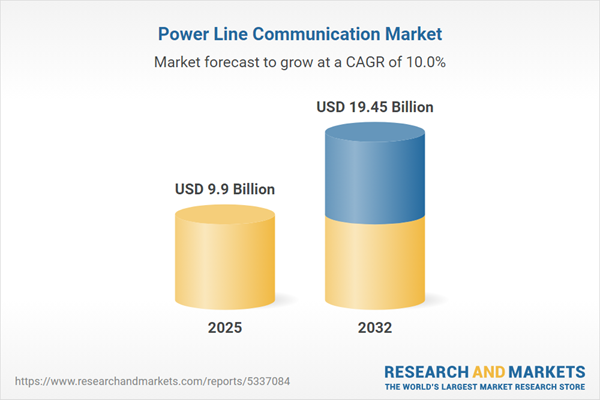Speak directly to the analyst to clarify any post sales queries you may have.
The power line communication market is rapidly redefining data transmission by utilizing existing grid infrastructure, unlocking new opportunities for scalable and reliable connectivity across smart grids, industry, and beyond.
Market Snapshot: Power Line Communication Market Size and Outlook
The power line communication market grew from USD 9.05 billion in 2024 to USD 9.90 billion in 2025. It is projected to expand at a CAGR of 10.03%, achieving USD 19.45 billion by 2032. This robust growth reflects accelerating demand for integrated communication and energy solutions across global industries and infrastructure developments.
Scope & Segmentation of the Power Line Communication Market
This in-depth analysis covers the breadth and depth of the power line communication (PLC) ecosystem, detailing major offerings, technologies, and end-user landscapes.
- Offering: Adapters, communication chips, couplers, modems, consulting, maintenance and repair, training and development, data acquisition and management software, energy management software.
- Modulation Technique: Discrete wavelet multitone (DWMT) modulation, filtered multitone (FMT) modulation, orthogonal frequency division multiplexing (OFDM), amplitude shift keying (ASK), frequency shift keying (FSK), phase shift keying (PSK), spread spectrum modulation.
- Frequency Band: Broadband PLC (greater than 500 kHz), narrowband PLC (3 kHz to 500 kHz).
- Industry Vertical: Automotive and transportation, energy and utilities, home and building automation, industrial automation, IT and telecommunications.
- Geography: Americas, Europe, Middle East and Africa, Asia-Pacific, with deep coverage of subregions such as North America, Latin America, Europe, the Middle East, Africa, and Asia-Pacific’s leading economies.
- Leading Companies: Advantech Co., Ltd.; Aftek AB; AMETEK, Inc.; Analog Devices, Inc.; D-Link Corporation; Devolo AG; EDMI Limited by Osaki Electric Co., Ltd.; General Electric Company; Hitachi, Ltd.; Hubbell Power Systems, Inc.; Infineon Technologies AG; Intel Corporation; Landis+Gyr AG; Marvell Technology, Inc.; Microchip Technology Incorporated; NXP Semiconductors N.V.; Panasonic Corporation; Qualcomm Incorporated; Renesas Electronics Corporation; Schneider Electric SE; Siemens AG; STMicroelectronics, N.V.; Texas Instruments Incorporated; Zyxel Communications Corp.
Key Takeaways for Senior Decision-Makers
- The power line communication market is evolving as a critical enabler for smart infrastructure, facilitating integration between energy distribution and advanced connectivity solutions.
- Innovations in multi-carrier and single-carrier modulation enhance signal robustness, enabling real-time monitoring, adaptive energy management, and improved process automation.
- Decarbonization initiatives and regional regulatory actions shape adoption dynamics, especially as governments emphasize interoperability and cybersecurity across energy and industrial networks.
- Segment-specific solutions, such as adaptive frequency bands and modular hardware, support emerging grid, industrial, and automation applications, offering flexibility and targeted value propositions.
- Collaborations among technology providers, utilities, and standardization bodies are fostering scalable frameworks that support seamless integration into both legacy grids and contemporary digital landscapes.
Tariff Impact on Cost Structures and Supply Chains
Recent tariff adjustments have increased the cost of critical PLC components, leading manufacturers to reevaluate global sourcing. Some organizations are shifting toward regional production and forming strategic alliances with local foundries, balancing cost pressures with compliance and innovation mandates. Policy incentives supporting domestic manufacturing are also prompting new collaborative supply models and driving modular product design.
Power Line Communication Market Methodology & Data Sources
This report’s foundation is a combination of direct engagement with industry stakeholders and comprehensive secondary analysis. Qualitative and quantitative data were gathered from executive interviews, technical standards, regulatory documentation, company filings, and reputable trade sources. Expert validation workshops ensured accuracy and relevance of all segmentation and strategic insights presented.
Why This Report Matters to Your Power Line Communication Strategy
- Delivers actionable insights on PLC market trends, disruptive technologies, and evolving regulatory environments to inform high-impact decisions across smart grids, automation, and digital transformation initiatives.
- Enables benchmarking of regional and global strategies, guiding investment in advanced modulation, robust cybersecurity, and agile sourcing to secure resilient competitive positioning.
Conclusion
The power line communication market presents significant strategic opportunities, driven by technological advances and global infrastructure needs. Organizations aligning with evolving regulation and embracing innovation will position themselves for sustainable advantage in this dynamic sector.
Additional Product Information:
- Purchase of this report includes 1 year online access with quarterly updates.
- This report can be updated on request. Please contact our Customer Experience team using the Ask a Question widget on our website.
Table of Contents
3. Executive Summary
4. Market Overview
7. Cumulative Impact of Artificial Intelligence 2025
Companies Mentioned
The companies profiled in this Power Line Communication market report include:- Advantech Co., Ltd.
- Aftek AB
- AMETEK, Inc.
- Analog Devices, Inc.
- D-Link Corporation
- Devolo AG
- EDMI Limited by Osaki Electric Co., Ltd.
- General Electric Company
- Hitachi, Ltd.
- Hubbell Power Systems, Inc.
- Infineon Technologies AG
- Intel Corporation
- Landis+Gyr AG
- Marvell Technology, Inc.
- Microchip Technology Incorporated
- NXP Semiconductors N.V.
- Panasonic Corporation
- Qualcomm Incorporated
- Renesas Electronics Corporation
- Schneider Electric SE
- Siemens AG
- STMicroelectronics, N.V.
- Texas Instruments Incorporated
- Zyxel Communications Corp.
Table Information
| Report Attribute | Details |
|---|---|
| No. of Pages | 195 |
| Published | November 2025 |
| Forecast Period | 2025 - 2032 |
| Estimated Market Value ( USD | $ 9.9 Billion |
| Forecasted Market Value ( USD | $ 19.45 Billion |
| Compound Annual Growth Rate | 10.0% |
| Regions Covered | Global |
| No. of Companies Mentioned | 25 |









